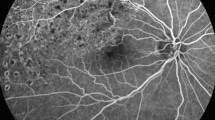Abstract
Purpose
To evaluate the neuroprotective efficacy of brimonidine applied topically to the eyes of patients undergoing laser treatment for extrafoveal or juxtafoveal choroidal neovascularization (CNV).
Method
In this prospective, controlled, double-masked pilot study, 20 eyes were randomized to receive either brimonidine 0.2% (study group, 11 eyes) or placebo (matched control group, 9 eyes). Medications were topically applied twice a day during a period of 4–48 h before laser treatment and were continued for 1 month.
Results
Two eyes in each group had severe visual loss owing to recurrence of CNV. In the remaining 16 eyes there was a significant improvement in the study group, but no improvement in the control group (P=0.027).
Conclusion
Topical brimonidine improves the visual outcome of laser-treated classic extrafoveal or juxtafoveal CNV, possibly by protecting the neuroretina against collateral damage caused by the laser treatment.

Similar content being viewed by others
References
Brancato R, Pece A, Avanza A, Radrizzani E (1990) Photocoagulation scar expansion after laser therapy for choroidal neovascularization in degenerative myopia. Retina 10:239–243
Dastgheib K, Bressler SB, Green WR (1993) Clinicopathologic correlation of laser lesion expansion after treatment of choroidal neovascularization. Retina 13:345–352
Donello JE, Padillo EU, Webster ML, Wheeler LA, Gil DW (2001) alpha(2)-Adrenoreceptor agonists inhibit vitreal glutamate and aspartate accumulation and preserve retinal function after transient ischemia. J Pharmacol Exp Ther 296:216a–223a
Ettaiche M, Fillacier K, Widmann C, Heurteaux C, Lazdunski M (1999) Riluzole improves functional recovery after ischemia in the rat retina. Invest Ophthalmol Vis Sci 40:729–736
Evans DW, Hosking SL, Gherghel D, Bartlett JD (2003) Contrast sensitivity improves after brimonidine therapy in primary open angle glaucoma: a case for neuroprotection. Br J Ophthalmol 87:1463–1465
Lafuente MP, Villegas-Perez MP, Sobrado-Calvo P, Garcia-Aviles A, Miralles de Imperial J, Vidal-Sanz M (2001) Neuroprotective effects of alpha(2)-selective adrenergic agonists against ischemia-induced retinal ganglion cell death. Invest Ophthalmol Vis Sci 42:2074–2084
Levkovitch-Verbin H, Harris-Cerruti C, Groner Y, Wheeler LA, Schwartz M, Yoles E (2000) RGC death in mice after optic nerve crush injury: oxidative stress and neuroprotection. Invest Ophthalmol Vis Sci 41:4169–4174
Lynch DR, Dawson TM (1994) Secondary mechanisms in neuronal trauma. Curr Opin Neurol 7:510–516
Macular Photocoagulation Study Group (1994) Laser photocoagulation for juxtafoveal choroidal neovascularization. Five-year results from randomized clinical trials. Arch Ophthalmol 112:500–509
Osborne NN, Cazevieille C, Carvalho AL, Larsen AK, DeSantis L (1997) In vivo and in vitro experiments show that betaxolol is a retinal neuroprotective agent. Brain Res 751:113–123
Osborne NN, DeSantis L, Bae JH, Ugarte M, Wood JP, Nash MS, Chidlow G (1999) Topically applied betaxolol attenuates NMDA-induced toxicity to ganglion cells and the effects of ischaemia to the retina. Exp Eye Res 69:331–342
Schuman JS, Horwitz B, Choplin NT, David R, Albracht D, Chen K (1997) A 1-year study of brimonidine twice daily in glaucoma and ocular hypertension. A controlled, randomized, multicenter clinical trial. Chronic Brimonidine Study Group. Arch Ophthalmol 115:847–852
Solberg Y, Rosner M, Turetz J, Belkin M (1997) MK-801 has neuroprotective and antiproliferative effects in retinal laser injuries. Invest Ophthalmol Vis Sci 38:1380–1389
Wen R, Cheng T, Li Y, Cao W, Steinberg RH (1996) Alpha 2-adrenergic agonists induce basic fibroblast growth factor expression in photoreceptors in vivo and ameliorate light damage. J Neurosci 116:5986–5992
Wheeler LA, Gil DW, WoldeMussie E (2001) Role of alpha-2 adrenergic receptors in neuroprotection and glaucoma. Surv Ophthalmol 245[Suppl 3]:S290–294; discussion S295–296
WoldeMussie E, Ruiz G, Wijono M, Wheeler LA (2001) Neuroprotection of retinal ganglion cells by brimonidine in rats with laser-induced chronic ocular hypertension. Invest Ophthalmol Vis Sci 42:2849–2855
Yoles E, Wheeler LA, Schwartz M (1999) Alpha2-adrenoreceptor agonists are neuroprotecrive in a rat model of optic nerve dgeneration. Invest Ophthalmol Vis Sci 40:65–73
Author information
Authors and Affiliations
Corresponding author
Rights and permissions
About this article
Cite this article
Ferencz, J.R., Gilady, G., Harel, O. et al. Topical brimonidine reduces collateral damage caused by laser photocoagulation for choroidal neovascularization. Graefe's Arch Clin Exp Ophthalmol 243, 877–880 (2005). https://doi.org/10.1007/s00417-005-1160-7
Received:
Revised:
Accepted:
Published:
Issue Date:
DOI: https://doi.org/10.1007/s00417-005-1160-7




